
You walk into your therapist’s office expecting the usual setup—comfy couch, tissue box, and an hour of “How does that make you feel?”
Instead, you find virtual reality goggles, gentle movement exercises, or your therapist asking about sensations in your body rather than just your thoughts.
Plot twist: This isn’t some futuristic fantasy. It’s happening right now.
Therapists across the country are quietly abandoning the traditional talk-therapy-only approach that’s dominated mental health for over a century. And here’s the kicker—the results are blowing everyone’s minds.
We’re talking 88% success rates compared to the 30-60% you might expect from conventional methods. Some approaches show effect sizes of 1.21, while traditional pharmacotherapy struggles around 0.30-0.40.
But before you think this is just another wellness trend, let me share what’s really driving this revolution.
The Uncomfortable Truth About Traditional Therapy
💡 Key Insight: While traditional therapy helps many people, the research foundation has significant gaps. This is why therapists are exploring evidence-based alternatives with stronger research backing.
Here’s something that might shock you: When researchers examined 247 studies on psychotherapy effectiveness, only 7% provided convincing evidence without significant bias.
Let that sink in for a moment.
Meanwhile, therapists are watching patients recover from decades of trauma in six sessions instead of six years using newer methods.
Dr. Arielle Schwartz experienced this firsthand. After a car accident left her with persistent anxiety, she tried EMDR therapy as a patient (not just a practitioner). Her description gives me chills:
“I felt sensations move through my body like waves that could finally reach the shore. At the end of several sessions I felt a profound shift; my distress around the accident disappeared.”
That’s when everything clicked for her. And for thousands of other therapists having similar “aha” moments.
What’s Actually Working (The Numbers Don’t Lie)

Let’s talk about what’s replacing the old-school approach:
EMDR: The Eye Movement Game-Changer
You might think moving your eyes back and forth while recalling trauma sounds weird. It is weird. It’s also incredibly effective.
The stats:
- Over 7 million people have been successfully treated across 130 countries
- 100% of single-trauma patients showed no diagnosable PTSD after just 6 sessions
- 77% of multiple-trauma patients achieved the same results
Compare that to traditional talk therapy, where you might process traumatic memories for years through conversation alone.
Psychedelic-Assisted Therapy: Yes, Really

Before you raise an eyebrow, this isn’t about getting high. It’s about breakthrough healing.
MDMA-assisted therapy shows 88% of severe PTSD patients achieving significant improvement compared to 60% with placebo. The FDA is expected to approve this approach in 2024.
Virtual Reality Therapy: Healing in Digital Worlds

Stanford’s 2024 trials show VR therapy working as well as traditional exposure therapy for depression and PTSD—but with higher patient satisfaction and lower dropout rates.
Facing your fears in a controlled virtual environment instead of just talking about them.
Somatic Therapy: Your Body Knows Things Your Mind Doesn’t

Here’s where it gets really interesting. Somatic experiencing therapy shows effect sizes of 0.94 to 1.26—that’s considered huge in research terms.
Why? Because trauma researcher Bessel van der Kolk nailed it: “Words can’t integrate the disorganized sensations and action patterns that form the core imprint of trauma.”
Your body keeps the score. These new approaches finally address that reality.
Why Therapists Are Making the Switch

I talked to therapists who’ve made this transition, and their stories are fascinating.
The personal transformation angle is huge. Many therapists first experience these methods as patients themselves, and then can’t go back to purely talk-based approaches.
Take the Brooklyn Somatic Therapy collective. Their therapists are certified in multiple approaches:
- Attachment Focused EMDR
- Hakomi Method
- Ketamine-Assisted Therapy
- Somatic IFS
They represent what therapy looks like when you stop limiting yourself to one toolbox.
But it’s not just about results—it’s about efficiency.
Beyond Psychology Center puts it perfectly: “Talk therapies often describe the issue without fixing it… That is because stress, anxiety and pain are rooted at the body level where unprocessed emotion, trauma, and life energy have become stuck.”
Why spend years talking in circles when you could address the root faster?
The Money Side of Things (Because Let’s Be Real)
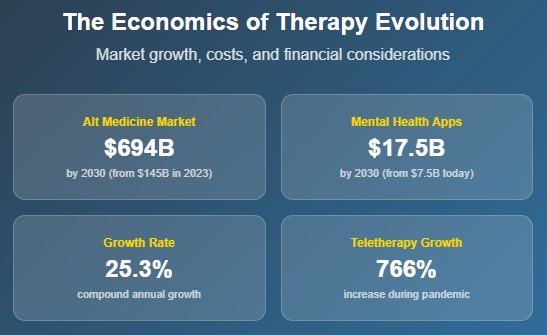
This transformation isn’t just happening in a vacuum. The economics tell a compelling story.
The market is exploding:
- The alternative medicine market is growing from $144.68 billion to $694.22 billion by 2030
- Mental health apps alone jumped from $7.48 billion to $17.52 billion
- Holistic therapy is showing the fastest projected growth rate
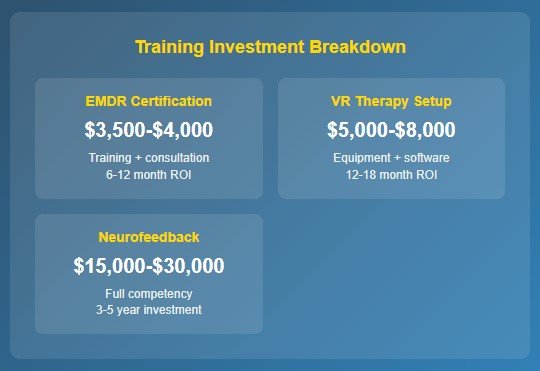
For therapists, the math works out too:
EMDR certification costs $3,500-$4,000 but allows charging $150-200 per session vs. traditional therapy’s $100-174 average. Most practitioners break even in 6-12 months.
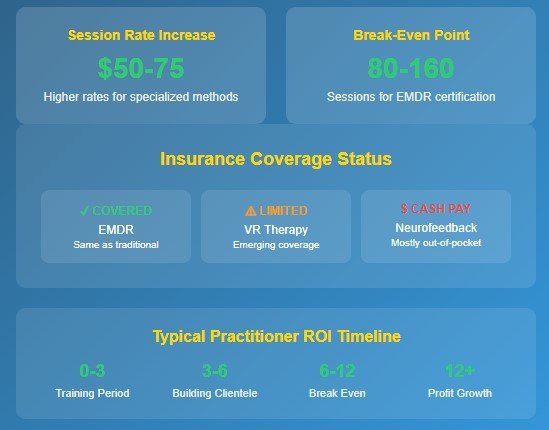
The insurance is mixed, though. Most major insurers treat EMDR like regular therapy. VR therapy faces limited coverage. Neurofeedback operates largely cash-pay.
This creates a concerning two-tier system where alternative therapies risk becoming premium services for higher-income patients.
The Challenges Are Real
• 10 practice sessions
• Basic consultation
• 25+ different clients
• 20 hours consultation
• Ongoing education
• 3-5 years practice
• Equipment expertise
• Ongoing consultation
Let’s be honest about the hurdles.
Training is intense. EMDR certification alone requires:
- EMDRIA-approved training
- 50+ clinical sessions with 25+ clients
- 20 hours of consultation
- Ongoing continuing education
Neurofeedback is even steeper—practitioners budget 3-5 years to achieve full competency, requiring technical expertise in brain monitoring systems.
Cost and time are the biggest barriers. Survey data shows insufficient time and learning costs as the most cited obstacles to adoption.
But here’s what practitioners say after making the switch:
“This training was TRULY LIFE-CHANGING, and I will forever be grateful. I am excited to see the effects this will have on my personal and professional life.”
Patient Stories That’ll Give You Hope

The real proof is in patient experiences.
A Paris terrorist attack survivor shared: “I was in the Paris attacks… came home thinking I was completely crazy… After EMDR, that night became less scary and less real, until eventually it became something that just happened a long time ago.”
A chronic fatigue patient reported: “My last 3 months of working with EMDR has been one of the most profound healing experiences in my life… I went from being significantly less mobile to walking as far as 8K.”
These aren’t cherry-picked success stories. Somatic experiencing research shows 90% of clients either had drastically improved lifestyles or no PTSD symptoms.
Where This Is All Heading
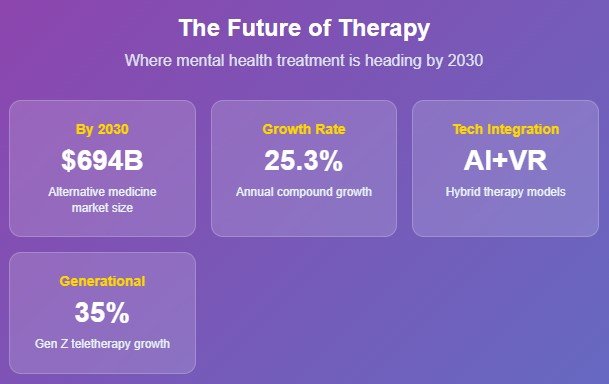
By 2030, therapy will look completely different.
The fastest-growing segment isn’t any single new method—it’s hybrid therapy models combining traditional and alternative approaches.
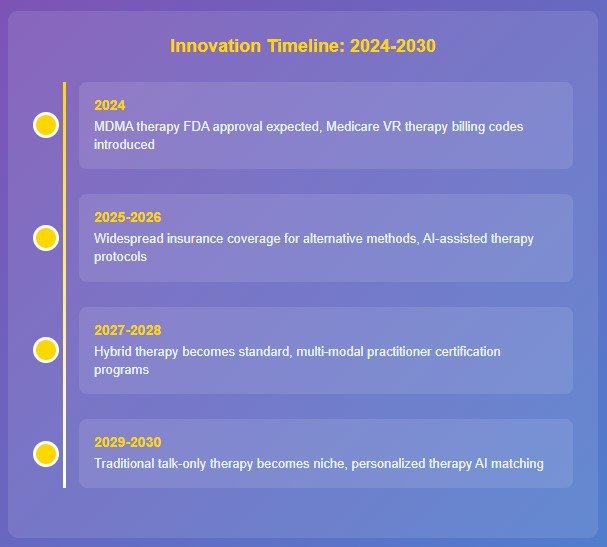
Demographics drive this change. Millennials and Gen Z show 35% growth in teletherapy usage and a strong preference for online platforms. This generation expects therapy that integrates technology, addresses the whole person, and delivers measurable results efficiently.
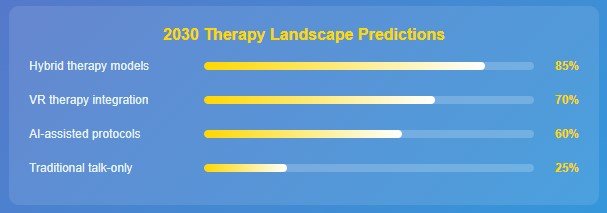
Insurance will catch up. European countries already reimburse VR therapy at premium rates. Medicare created billing codes for virtual reality cognitive behavioral therapy devices in 2023.
The economic pressure to cover effective treatments that reduce long-term healthcare costs will drive broader coverage.
The Bigger Picture
- Talk therapy only
- Mind-focused treatment
- Weekly 50-minute sessions
- Years of processing
- One-size-fits-all
- Limited technology use
- Multi-modal integration
- Whole-person healing
- Flexible session formats
- Weeks to breakthrough
- Personalized protocols
- Technology-enhanced
This isn’t just about changing techniques—it’s about fundamentally reimagining what healing means.
Traditional therapy asks: “How does that make you feel?”
New approaches ask: “What does your body need to release this? How can we rewire these patterns? What would it look like to heal this completely?”
The resistance is crumbling fast. Professional associations now recognize multiple alternative approaches. Training programs emphasize integration over single theoretical orientations.
Major medical centers are establishing integrative mental health programs. Even corporate wellness initiatives incorporate these methods.
What This Means for You

If you’re struggling with mental health challenges, you now have options your parents’ generation never had.
Instead of choosing between talking and medication, you can access approaches that work with your entire human system.
Here’s what to look for:
- Therapists certified in multiple modalities
- Practices offering somatic or body-based approaches
- Integration of technology or alternative methods
- Focus on nervous system regulation, not just thoughts
Questions to ask potential therapists:
- What training do you have beyond traditional talk therapy?
- How do you address trauma stored in the body?
- What’s your approach to faster, more effective treatment?
The Bottom Line
The therapy revolution isn’t coming—it’s already here.
Every week, more therapists are expanding beyond the limitations of talk-only therapy. More patients are experiencing breakthrough healing in weeks instead of years.
The question isn’t whether these approaches will become mainstream—the evidence and economics make that inevitable.
The question is: Are you ready to explore what’s possible when therapy finally catches up with what we know about how humans actually heal?
Your future self might thank you for looking beyond the couch.
Ready to explore these new approaches? Start by researching EMDR or somatic therapists in your area. Many offer consultations where you can learn about their methods and see if they’re a good fit for your healing journey.






